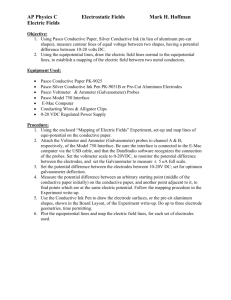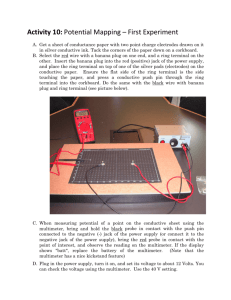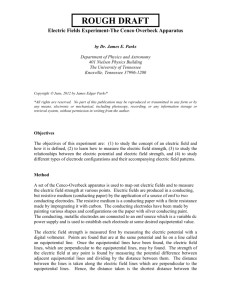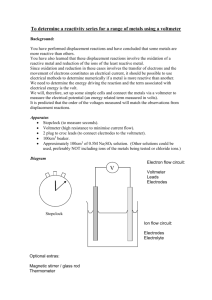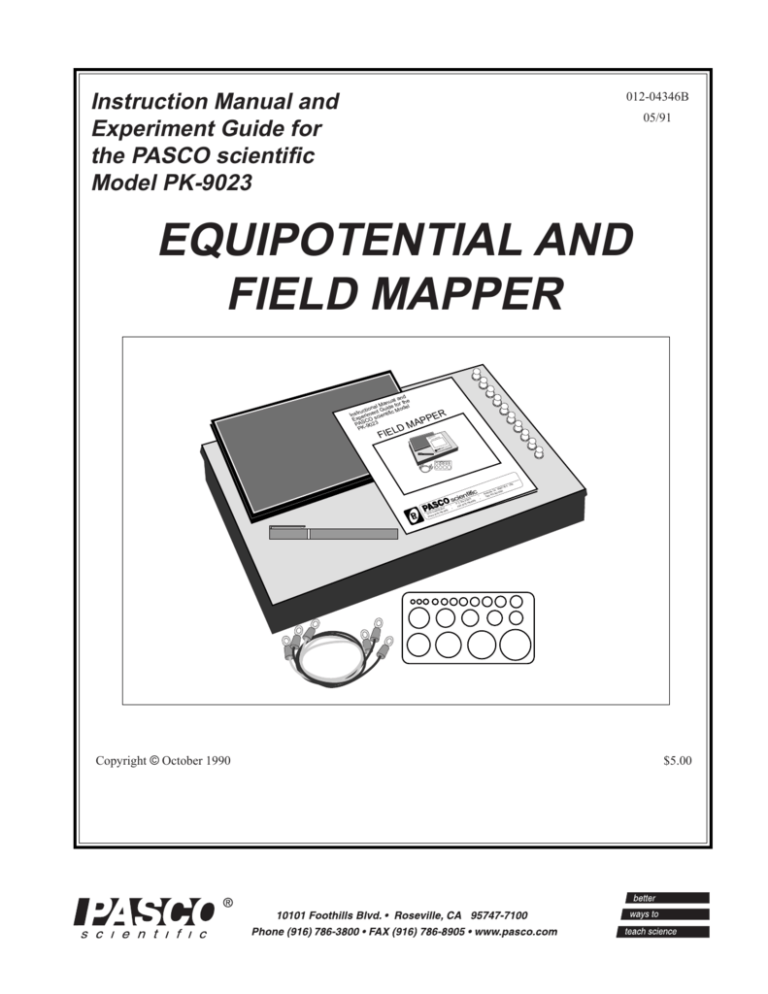
012-04346B
Instruction Manual and
Experiment Guide for
the PASCO scientific
Model PK-9023
05/91
EQUIPOTENTIAL AND
FIELD MAPPER
d
l an
nua for the
l Ma
l
ona uide ode
ucti ent G tific M
tr
s
In perim scien
Ex SCO
PA -9023
PK
LD
FIE
PER
MAP
l and
Manua for the
tional Guide Model
fic
Instruc ment
Experi scienti
PASCO23
PK-90
LD
PER
MAP
FIE
USA
tific
scien
•
Blvd.
Foothills786-3800
10101 (916)
Phone
•
619011
Box
P. O. (916) 786-8905
FAX
•
•
95661-9011
CA
Roseville,
910-383-2040
TWX
c
ntifi
scie
•
Blvd.
othills 6-3800
1 Fo
78
1010 e (916)
Phon
Copyright © October 1990
•
11
6190 905
Box
6-8
P. O. (916) 78
FAX
•
•
A
1 US
1-901
9566
CA
ville,
-2040
Rose 910-383
TWX
$5.00
012-04346B
Table of Contents
Section
Page
Copyright, Warranty, and Equipment Return ................................................... ii
Introduction ...................................................................................................... 1
Equipment ......................................................................................................... 1
Equipment Setup............................................................................................... 2
Experiments
Parallel Plate Capacitor ........................................................................ 4
Point Source and Guard Ring ............................................................... 4
Dipoles of Opposite Charge ................................................................. 5
Dipoles of Like Charge......................................................................... 5
Floating Electrode................................................................................. 6
Floating Insulator .................................................................................. 6
Line and Circular Source ...................................................................... 7
Line and "Sharp" Point ......................................................................... 7
Triode.................................................................................................... 8
Fluid Mechanism .................................................................................. 8
Appendix: Silver conductive ink Material Safety Data Sheet .......................... 9
i
scientific
012-04346B
Copyright and Warranty
Please—Feel free to duplicate this manual
subject to the copyright restrictions below.
Copyright Notice
The PASCO scientific Model PK-9023 Equipotential and
Field Mapper manual is copyrighted and all rights reserved.
However, permission is granted to non-profit educational
institutions for reproduction of any part of this manual
providing the reproductions are used only for their laboratories and are not sold for profit. Reproduction under any
other circumstances, without the written consent of PASCO
scientific, is prohibited.
which is deemed to be defective in material or workmanship. This warranty does not cover damage to the product
caused by abuse or improper use. Determination of whether
a product failure is the result of a manufacturing defect or
improper use by the customer shall be made solely by
PASCO scientific. Responsibility for the return of equipment for warranty repair belongs to the customer. Equipment must be properly packed to prevent damage and
shipped postage or freight prepaid. (Damage caused by
improper packing of the equipment for return shipment will
not be covered by the warranty.) Shipping costs for
returning the equipment, after repair, will be paid by
PASCO scientific.
Limited Warranty
PASCO scientific warrants this product to be free from
defects in materials and workmanship for a period of one
year from the date of shipment to the customer. PASCO
will repair or replace, at its option, any part of the product
Equipment Return
Should this product have to be returned to PASCO scientific,
for whatever reason, notify PASCO scientific by letter or
phone BEFORE returning the product. Upon notification,
the return authorization and shipping instructions will be
promptly issued.
will not be damaged in shipment, observe the following
rules:
1. The carton must be strong enough for the item shipped.
NOTE: NO EQUIPMENT WILL BE ACCEPTED
FOR RETURN WITHOUT AN AUTHORIZATION.
When returning equipment for repair, the units must be
packed properly. Carriers will not accept responsibility for
damage caused by improper packing. To be certain the unit
scientific
ii
2.
Make certain there is at least two inches of packing
material between any point on the apparatus and the
inside walls of the carton.
3.
Make certain that the packing material can not shift in
the box, or become compressed, thus letting the
instrument come in contact with the edge of the box.
012-04346B
Introduction
The PASCO scientific MODEL PK-9023 Field Mapper
consists of two basic elements. The first is a carbon impregnated paper in the resistance range of 5 KΩ to 20 KΩ per
square. This paper forms the conducting medium or space
between the electrodes. The second element is a conductive
ink dispensed from a pen. The ink is produced from silver
particles in a suspension liquid. As the ink dries, the silver
flakes settle on top of each other forming a conductive path,
(or conductive ink electrodes). The resistance of the ink is
between .03 and .05 Ω/cm for a 1 mm wide line.
-
Because the paper has a finite resistance, a current must flow
through it to produce a potential difference. This current is
supplied by the conductive ink electrodes which causes a
potential drop to occur across the paths. Because of the
large difference between the ink’s resistance and the
resistance of the paper, this potential drop is less than 1% of
that produced across the paper. Therefore, for all practical
purposes the potential drop across the electrodes may be
considered negligible.
+
Equipotential and Field Lines
It would be desirable that the potential measuring instrument
have an infinite impedance. An electrometer such as the
PASCO Model ES-9054B would be optimal, however, a
standard electronic voltmeter such as PASCO's SE-9589
Handheld Digital Multimeter with a 10 MΩ (or higher) input
impedance is sufficient. Since this impedance is at least 100
times greater than that of the paper, the greatest distortion of
the field which can be produced by the voltmeter is approximately 1%.
Equipment
The PK-9023 Field Mapper includes:
and
ual the
l Man for
iona t Guidec Model
ruct
ifi
Inst erimen
ient
Exp SCO sc
3
A
P -902
PK
LD
FIE
• 100 sheets of conductive paper with 23 x 30 cm grid
• a silver conductive ink pen for approximately 200 ft of
continuous line
• a corkboard working surface
• 10 push pins for attaching the paper to the board
• 3 wires for connecting the conductive paths
• a circle template for drawing the conductive paths.
• a large plastic tray for storing the paper and other
supplies
• Instruction manual and experiment guide.
PER
MAP
and
the
al Manualfor
t Guide Model
Instruction scientific
Experimen
PASCO
PK-9023
ER
MAPP
FIELD
USA
c
scientifi
•
Blvd.
•
619011
Box
P. O. (916) 786-8905
FAX
•
•
95661-9011
CA
Roseville,
910-383-2040
TWX
Foothills786-3800
10101 (916)
Phone
c
ntifi
scie
.
s Blvd 00
-38
Foothill
10101 (916) 786
Phone
•
•
619011 05
-89
Box
P. O. (916) 786
FAX
•
•
USA
9011
9566140
le, CA
Rosevil910-383-20
TWX
The following supplies can be ordered separately
from PASCO scientific
Conductive ink pen
Model No. PK-9031B
100 sheets of 23 x 30 cm conductive paper with cm grid
Model No. PK-9025A
100 sheets of 30 x 46 cm conductive paper (without grid)
Model No. PK-9026A
scientific
1
012-04346B
Equipment Setup
IMPORTANT:
The silver conductive ink reaches its maximum
conductivity after 20 minutes drying time. For
optimal results plan the timetable for conducting the
experiments and correlate drawing the conductive
ink paths accordingly.
1.
Plan and sketch the layout (size, shape and relative
spacing) of the charged paths to be studied on a piece of
scratch paper. These paths can be any two dimensional
shape, such as straight or curved lines, circles, dots,
squares, etc. Since the charged paths will actually be
conductive ink electrodes, they will be referred to as
electrodes.
2.
Draw the electrodes on the black paper (see Figure 1).
Figure 1
NOTE: This is the most difficult and crucial part
of the experiment. Follow these steps carefully.
e. A plastic template is included with the PASCO
scientific Field Mapper, for drawing circles. (see
Figure 3) Place the template on the conductive
paper and draw the circles with the conductive ink
pen. (If desired, you may first draw the circle
template with a soft lead pencil and trace over the
pencil line with the ink.)
a. Place the conductive paper, printed side up, on a
smooth hard surface. DO NOT attempt to draw the
electrodes while the paper is on the corkboard.
b. Shake the conductive ink pen (with the cap on)
vigorously for 10-20 seconds to disperse any
particle matter suspended in the ink.
c. Remove the cap. Pressing the spring loaded tip
lightly down on a piece of scrap paper while
squeezing the pen barrel firmly starts the ink
flowing. Drawing the pen slowly across the paper
produces a solid line. Drawing speed and exerted
pressure determines the path width. (see Figure 2)
Figure 3
Figure 2
3.
Mount the conductive paper on the corkboard using one
of the metal push pins in each corner.
d. Once a satisfactory line is produced on the scrap
paper, draw the electrodes on the black conductive
paper. If the line becomes thin or spotty, draw
over it again. A solid line is essential for good
measurements.
The line will be air dry in 3-5 minutes at room
temperature. However, the medium won’t reach
maximum conductivity until after 20 minutes
drying time.
2
scientific
012-04346B
4.
5.
Connect the electrodes to a battery, DC power supply,
or any other potential source in the 5 to 20 VDC range
using the supplied connecting wires. (see Figure 4) The
potential source should be capable of supplying 25 mA.
(If possible, the potential should be equal to the full
scale reading of the electronic voltmeter used in the
experiment.)
To check the electrodes for proper conductivity connect
one voltmeter lead near the push pin on an electrode.
Touch the voltmeter’s second lead to other points on the
same electrode. If the electrode has been properly
drawn, the maximum potential between any two points
on the same electrode will not exceed 1% of the
potential applied between the two electrodes.
NOTE: This test can only be made if the potential
source is connected across the two electrodes.
If the voltage across the same electrode is greater than
1% of the voltage applied between the two electrodes,
then remove the paper from the corkboard and draw
over the electrodes a second time with the conductive
ink.
M
6.
DC Power
supply
Meter
To map an equipotential, move the probe until the
desired potential is indicated on the voltmeter. Mark the
paper at this point with a soft lead or light-colored lead
pencil. Continue to move the probe, but only in a
direction which maintains the voltmeter at the same
reading. Continue to mark these points. Connecting the
points produces an equipotential line.
Figure 4
a. Place the terminal of a connecting wire over the
electrode, then stick a metal push pin through its
terminal and the electrode into the corkboard.
Make certain that the pin holds the terminal firmly
to the electrode. (see Figure 5).
7.
Connecting
wire
Push pin
Paper
Electrode
Figure 5
NOTE: Check that the surface of the terminal
which touches the electrode is clean. A dirty path
may result in a bad contact.
To plot field gradients (field lines), neither lead of the
voltmeter is connected to an electrode. Instead, the two
leads of the voltmeter will be placed on the conductive
paper side-by-side at a set distance of separation (one
centimeter is a useful separation to use). It is best to tape
the two leads of the voltmeter together for this procedure (see Figure 7). The technique is to use the voltmeter leads to find the direction from an electrode that
follows the path of greatest potential difference from
point-to-point.
NOTE: Do Not attempt to make measurements by
placing the leads on the grid marks on the conductive paper. Touch the voltmeter leads only on the
solid black areas of the paper. It may be necessary
to use a higher voltmeter sensitivity for this
measurement than was used in measuring
equipotentials.
Connect the other end of the wire to the battery.
THE ELECTRONIC VOLTMETER
Two specifications which a voltmeter must meet in
order to be used with the PASCO scientific Field
Mapper are
To plot the field lines on the conductive paper, place the
voltmeter lead connected to ground near one of the
dipoles. Place the other voltmeter lead on the paper and
note the voltmeter reading. Now pivot the lead to
several new positions while keeping the ground lead
stationary (see Figure 7). Note the voltmeter readings as
you touch the lead at each new spot on the paper. When
the potential is the highest, draw an arrow on the paper
from the ground lead to the other lead (see Figure 8).
Then move the ground lead to the tip (head) of the
• first, an input impedance of 10 MΩ or higher
• second, a full scale range which is equal to or higher
than the potential used across the electrodes.
Any commercial electronic voltmeter, either digital
or analog, that meets these specifications is adequate. The PASCO ES-9054B Electrometer or the
SE-9589 Handheld Digital Multimeter are recommended.
scientific
Equipotentials are plotted by connecting one lead of the
voltmeter (the ground) to one of the electrode push pins.
This electrode now becomes the reference. The other
voltmeter lead (the probe) is used to measure the
potential at any point on the paper simply by touching
the probe to the paper at that point.
3
012-04346B
arrow. Repeat the action of pivoting and touching with
the front lead until the potential reading in a given
direction is highest. Draw a new arrow. Repeat the
action of putting the ground lead at the tip (head) of
each new arrow and finding the direction in which the
potential difference is highest. Eventually , the arrows
drawn in this manner will form a field line. Return to the
dipole and select a new point at which to place the
voltmeter's ground lead. Again probe with the other lead
until the direction of highest potential difference is
found. Draw an arrow from the ground lead to the other
lead, and repeat the process until a new field line is
drawn. Continue selecting new points and drawing field
lines around the original dipole (see Figure 6).
1st line
Dipole
Dipole
2nd line
3rd line
Figure 6 (Example of 3 field lines between unlike dipoles)
Ground lead for
voltmeter
Tape
Area to probe in order to
find highest potential
difference
Conductive
paper
Pushpin
Electrode to voltage
source (battery or
power supply)
Figure 7
Figure 8
4
scientific
012-04346B
Experiments
The following are only some suggested experiments in
mapping equipotentials and field gradients using the PASCO
Field Mapper. The true value of the equipment, lies in its
complete flexibility permitting the user to design any system
of charged bodies and then to map the equipotentials and
field gradients.
NOTE: Only power supply connections are shown
in the following schematics. Voltmeter connections
are not shown because they vary depending on
whether equipotentials or field gradients are being
mapped.
Point Source and Guard Ring
Parallel Plate Capacitor
d
+
l
DC
Source
+
Electrodes
Connecting
wires
Questions
Questions
What is the field outside the capacitor plates?
What relation can be derived between the distance from the
center of the point source and the equipotential value?
How does the ratio of the plate length (l) versus separation
(d) affect the fringing effect at the edges of the plates?
Would this same relation hold if the system were three
dimensional?
What redesign of the plates, or perhaps extra electrodes,
could help eliminate the fringing effect?
scientific
What purpose does the large outer ring serve in this experiment?
5
012-04346B
Dipoles of Opposite Charge
Dipoles of Like Charge
+
+
Questions
Questions
What is the relation between the direction of a maximum
value field gradient and equipotential line at the same point?
(A geometrical relation is desired.)
How does the field of this configuration compare with
dipoles of opposite charge? (See experiment “Dipoles of
Opposite Charge”.)
What effect does the finite size of the black paper have on
the field?
What distortion of the field is produced by the large electrode around the perimeter of the paper?
6
scientific
012-04346B
Floating Insulator
Floating Electrode
Rectangular cut-out
+
+
Before drawing the circular electrode, map the equipotentials
of the two straight electrodes. Draw the circular electrode
and again map the equipotentials.
Before cutting the rectangular insulator, map the
equipotentials of the two straight electrodes. Cut out a
rectangular section of the paper and again map the
equipotentials.
Questions
How does the circular electrode distort the field?
Questions
How does the rectangular insulator distort the field?
What is the potential of the circular electrode? Of the area
inside the electrode?
What effect would moving the rectangular insulator have?
What effect would moving the circular electrode have?
scientific
7
012-04346B
Line and Circular Source
Line and “Sharp” Point
b
a
a
+
+
a
c
At first, do not draw the two electrodes marked “a.” Map
the equipotentials. Add the electrodes “a” and again map the
equipotentials.
Draw only the line and point source “a.” Map the
equipotentials. Add circular electrode “b” and again map the
equipotentials. Add circular electrode “c” and again map the
equipotentials.
Questions
What effect did adding the extra electrodes have on the
spacing of the equipotentials (field strength) around the
point?
Questions
How is the spacing of equipotentials affected by the increasing diameter of the circular electrode?
Why did the field strength change even though the radius of
the point did not change?
8
scientific
012-04346B
Triode
flow and electric fields. In particular, the velocity potential
of an incompressible fluid where the flow is both steady and
not rotational satisfies the Laplace equation. A steady flow
of water is a good approximately of this type of flow. Now
the flow is generated by “sources” which supply fluid and
“sinks” which absorb fluid. We are interested in the
“streamlines” which can be thought of as lines traced out by
a particular particle in the fluid. The streamlines begin at the
sources and end at the sinks.
Equipment needed but not supplied: 5K Potentiometer
a
+
Turning to the Field Mapper, we need to draw electrodes in
the shape of the sources and sinks in the fluid flow to be
examined. Then the electric field lines which we plot
coincide with the streamlines in the fluid flow. (Remember
that the electric field lines are perpendicular to the equipotential lines.) If there is some fixed obstruction in the fluid
glow, we can represent it by cutting the same shape from the
conductive paper. The schematic drawing shows a fluid
flow which is analogous to the flow in a section of pipe
(with frictionless walls). This source is a straight line at the
left, the sink is a straight line at the right. The tear-drop
shaped section cut out of the middle is some obstruction.
The field lines are the corresponding streamlines.
a
5K
Potentiometer
Use a 5 K potentiometer to provide three potentials. Connect the three short electrodes with wires “a.” Do not let
these wires touch the black paper except at the conductive
ink electrodes.
Questions
To use the Field Mapper to examine fluid flows, follow these
steps.
How is the field in the area between the short electrodes
affected by the potential between the short electrodes and the
closer, long electrode?
Could this paper model of a triode act as an amplifying
device? If not, why not?
Fluid Mechanics Experiments
+
-
Cut-out shape
The PASCO Field Mapper can also be used to examine fluid
flow. In many fluid systems the velocity potential satisfies
the Laplace equations (so does the electromagnetic potential). Consequently, there is a direct analogy between fluid
scientific
9
1.
Make sure that the fluid is incompressible and the flow
is not rotational and steady.
2.
Draw electrodes on the conductive paper in the same
shape and position as the sources and sinks in the flow.
3.
Cut out sections of the conductive paper in the same
shape and position as the obstructions in the fluid.
4.
Connect a battery between the sources and sinks. All
sources should be connected to the same side of the
battery. All sinks should be connected to the opposite
side.
5.
Plot the equipotentials and draw lines perpendicular to
these. You can also pick any point and determine the
direction of the maximum field gradient. This is the
direction of the streamlines at that point.
012-04346B
Notes
10
scientific
012-04346B
Appendix
scientific
11
012-04346B
12
scientific
Technical Support
Feedback
Contacting Technical Support
If you have any comments about the product or
manual, please let us know. If you have any suggestions on alternate experiments or find a problem in the
manual, please tell us. PASCO appreciates any
customer feedback. Your input helps us evaluate and
improve our product.
Before you call the PASCO Technical Support staff,
it would be helpful to prepare the following information:
To Reach PASCO
For technical support, call us at 1-800-772-8700
(toll-free within the U.S.) or (916) 786-3800.
fax:
(916) 786-3292
e-mail: techsupp@PASCO.com
web:
www.pasco.com
➤ If your problem is with the PASCO apparatus,
note:
- Title and model number (usually listed on the
label);
- Approximate age of apparatus;
- A detailed description of the problem/sequence
of events. (In case you can’t call PASCO right
away, you won’t lose valuable data.);
- If possible, have the apparatus within reach
when calling to facilitate description of individual parts.
➤ If your problem relates to the instruction manual,
note:
- Part number and revision (listed by month and
year on the front cover);
- Have the manual at hand to discuss your questions.

